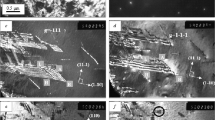Abstract
The effects of hydrogen charging on the dislocation behaviour in Ni-Cr binary alloys have been investigated by means of transmission electron microscope (TEM) observations using single-crystalline specimens. The deformation mode of Ni-Cr alloys in the absence of hydrogen is characterized by planar dislocations. However, hydrogen charging changed the dislocation configurations to promote curved dislocations, such as dislocation loops and dipoles. The hydrogen-affected dislocation configurations are enhanced with increasing Ni content and reducing Cr content. Weak-beam images show that the Shockley partials of the hydrogen-affected dislocations frequently constrict to make kinks and cross-slip, as if the dislocations were generated by a thermally activated process. The effect of hydrogen charging on superdislocations of a Ni2Cr superstructure has been also investigated using an aged 70Ni-30Cr alloy. While the deformation mode in the Ni2Cr superlattice is classified as five variants of superdislocation triplets and one variant of ordinary dislocations, the hydrogen charging has preferred the ordinary dislocations to the superdislocation triplets. The results suggest that the charged hydrogen changes the local plasticity to affect the deformation dynamics in Ni-Cr alloys, where the influence of hydrogen on the plasticity is sensitive to the Ni/Cr concentration and the symmetry of atomic arrangement.
Similar content being viewed by others
References
P.R. Rhodes: Corrosion ’86, NACE, Houston, TX, 1986, paper no. 322.
A.I. Asphahani: Metals Handbook, 9th ed., vol. 13, Corrosion, ASM INTERNATIONAL, Metals Park, OH, 1987.
W.Z. Friend: Corrosion of Nickel and Ni-Base Alloys, John Wiley & Sons, New York, NY, 1980, pp 1–31.
A.I. Asphahani: Proc. 2nd Int. Congr. on Hydrogen in Metals, Paris, 1977, Section H-2, paper no. 3C-2.
R.H. Jones and S.M. Bruemmer: in Environment Induced Cracking of Metals, R.P. Gangloff and M.B. Ives, eds., National Association of Corrosion Engineers, Houston, TX, 1990, p. 287.
G.C. Smith: in Hydrogen in Metals, I.M. Bernstein and A.W. Thompson, eds., ASM, Metals Park, OH, 1974, pp. 485–513.
B.J. Berkowitz and R.D. Kane: Corrosion, 1980, vol. 36, pp. 24–28.
S. Hinotani, Y. Ohmori, and F. Terasaki: Mater. Sci. Technol., 1985, vol. 1, pp. 297–304.
A.W. Thompson and I.M. Bernstein: in Advances in Corrosion Science and Technology, The Role of Metallurgical Variables in Hydrogen-Assisted Environmental Fracture, R.W. Staehle and M.G. Fontana, eds., Plenum Press, New York, NY, 1977, vol. 7, p. 249.
N. Scidhar, J.A. Kargol, and N.F. Fiore: Scripta Metall., 1980, vol. 14, pp. 1257–60.
K. Miyata and M. Igarashi: Metall. Trans. A, 1992, vol. 23A, pp. 953–61.
K. Miyata and M. Igarashi: Proc. Int. Symp. Plant Aging and Life Prediction of Corrodible Structures, Japan Society of Corrosion Engineering and NACE International, Sapporo, Japan, 1995, pp. 599–605.
A.R. Troiano: Trans. Am. Soc. Met., 1960, vol. 52, p. 54.
R.A. Oriani and P.H. Josephic: Acta Metall., 1974, vol. 22, pp. 1065–74.
C.D. Beachem: Metall. Trans., 1972, vol. 3, pp. 437–51.
H.K. Birnbaum: in Atomistic of Fracture, R.M. Latanision and J.R. Pickens, eds., Plenum Press, New York, NY, 1983, pp. 733–69.
J. Eastman, F. Heubaum, T. Matsumoto, and H.K. Birnbaum: Acta Metall., 1982, vol. 30, pp. 1579–86.
R.E. Stoltz, A.J. West, I.M.E. Bernstein, and I.M. Thompson: Hydrogen Effects in Metals, AIME, Warrendale, PA, 1981, pp. 541–53.
J.P. Hirth: Theory of Dislocations, John Wiley & Sons, New York, NY, 1982, pp. 240–41.
J. Friedel: Dislocations, Pergamon Press, Elmsford, Oxford, 1964, pp. 161–65.
J.P. Hirth: Theory of Dislocations, John Wiley & Sons, New York, NY, 1982, pp. 460–67.
S. Amelinckx: in Dislocation in Solids, F.R.N. Nabarro, ed., North-Holland Publishing Company, Amsterdam, 1982, vol. 2, pp. 270–72.
J.W. Christian and D.E. Laughlin: Acta Metall., 1988, vol. 36, pp. 1617–42.
Author information
Authors and Affiliations
Rights and permissions
About this article
Cite this article
Miyata, K. Effect of hydrogen charging on dislocation behavior in Ni-Cr and Ni2Cr alloys. Metall Mater Trans A 34, 1249–1257 (2003). https://doi.org/10.1007/s11661-003-0235-5
Received:
Issue Date:
DOI: https://doi.org/10.1007/s11661-003-0235-5




